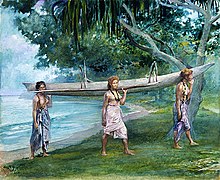


Vaʻa is a word in Samoan, Hawaiian and Tahitian which means 'boat', 'canoe' or 'ship'.[1] A larger traditional seagoing vessel for long-distance voyages is referred to as vaʻa tele (big ship). The term alia is also used for larger vessels in Samoa. The smaller vaʻa used for fishing typically have a float, or outrigger, attached to the main hull for stability. This outrigger part of the canoe is called ama in various Polynesian languages.
The word is cognate with other Polynesian words such as vaka or the Māori word waka.[2] It is also used to designate the sport of outrigger canoe racing. Due to the extra stability created by an outrigger system, a modified version of the va'a canoe was included as a new Paralympic Games event from 2020.

The Samoans have four kinds of canoes, smaller fishing vessels or the larger oceangoing va'a-teleorʻalia, which are mostly out of use today;[3]

A main hull of a vaʻa can be made in one piece, from a hollowed out trunk of a large tree with the ama float attached later. Other types of Polynesian construction include 'sewing' planks of wood together with special cords and ropes, a type of hand made sennit, important in the material cultures of the people of Oceania.
Vaʻa is also a surname in the Samoa Islands, and may refer to:
|
| ||
|---|---|---|
| Commercial |
| |
| Traditional |
| |
| Dories |
| |
| Oyster boats |
| |
| Recreational |
| |
| Builders and designers |
| |
| ||